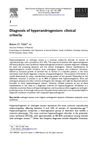S124 Variants of Myxoid Cysts: Diagnosis and Treatment
TLDR Common hair loss can be diagnosed with a physical exam and sometimes a hair test or skin biopsy, and treated with medication or surgery, with ongoing treatment needed to keep results.
The document from 1997 discusses the diagnosis and treatment of androgenetic alopecia (AGA), which is the most common cause of hair loss, affecting up to 50% of men and 40% of women by age 50. AGA diagnosis is typically made through medical history and physical examination, with a trichogram to assess hair loss progression and a scalp biopsy for definitive diagnosis, though the latter is often unnecessary. Women with signs of hyperandrogenism should be screened for ovarian or adrenal disorders. Treatment for mild to moderate AGA in men includes oral finasteride, which showed clinical improvement in up to 66% of patients after 2 years, and topical minoxidil. These treatments should be continued indefinitely to maintain results. Women with mild to moderate AGA may benefit from oral antiandrogens or topical minoxidil. For severe cases, hair systems and surgery are options. Patients should be educated on AGA's pathogenesis, and when used correctly, medical treatments can halt disease progression and reverse hair miniaturization in most patients with mild to moderate AGA.

